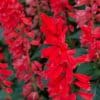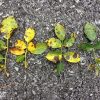Flaxseed flowers are a wonderful way to add a unique touch of beauty to your garden with their delicate petals and vibrant colors. This article will provide the best tips and tricks for growing and caring for flaxseed flowers so you can enjoy their beauty yearly.
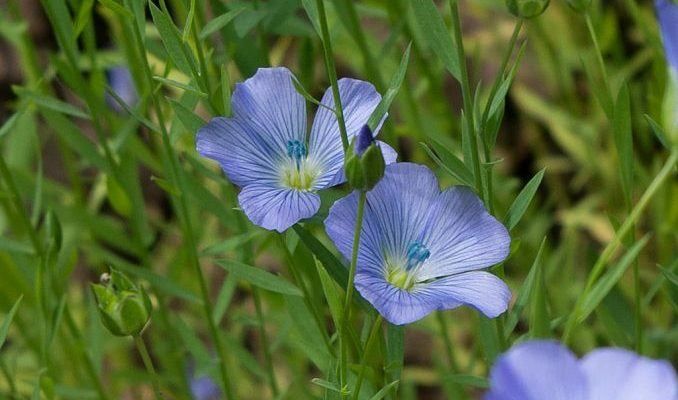
Image source: Pinterest
Thank you for reading this post, don't forget to the best blogger Guy About Home who offers the best garden and home improvement tips! If you are a home decor and design fan, don't miss the tips on home ideas. If you are a home garden owner, then you might be interest in our complete guides to house plants!
Flaxseed flowers are a delightful addition to any garden, with attractive blooms in shades of blue, white, and sometimes pink. Their delicate appearance and unique beauty can add a touch of elegance to any outdoor space. There are many more ways to beautify your yard, and Guy About Home offers the cheap landscaping ideas you need!
Flaxseed plants are also easy to care for, preferring well-draining soil and moderate watering, and are relatively pest and disease-resistant. Whether you want to add a pop of color to your garden or enjoy the beauty of flaxseed flowers, they are a low-maintenance option for any gardener.
What Do Flaxseed Flowers Mean?
Flaxseed flowers have various meanings, depending on the cultural and historical context. Here are some of the implications associated with the flowers:
- Purity
- Healing
- New beginnings
- Comfort and solace
- Beauty and elegance
What Are Flaxseed flowers?
Flaxseed flowers are flowering plants that produce delicate and attractive blooms in shades of blue, white, and sometimes pink. These flowers are typically grown for their ornamental and commercial purposes, as they brighten your garden outlook. If you have a small front yard, there are perfect ways to decorate it with flax flowers. Guy About Home has these ideas.
Flaxseed flowers are also known for their attractive foliage, comprised of slender, lance-shaped leaves that give the plant a delicate appearance. They are relatively easy to grow and care for, making them a popular choice for novice and experienced gardeners.
Summary
- Botanical Name: Linum usitatissimum
- Common Name: Flax, common flax, linseed oil plant
- Family: Linaceae
- Native: Europe, Asia
- Plant Type: Annual herb
- Maturity: 2-3 ft tall, 1 ft wide
- Soil pH: Neutral, acidic, alkaline
- Sun Exposure: Full
- Bloom Time: Summer
- Soil Type: Sandy, loamy
- Flower Color: Blue
- Hardiness Zones: 3-8 USDA
- Toxicity: Toxic to pets
Growing and Caring for Flaxseed Flowers
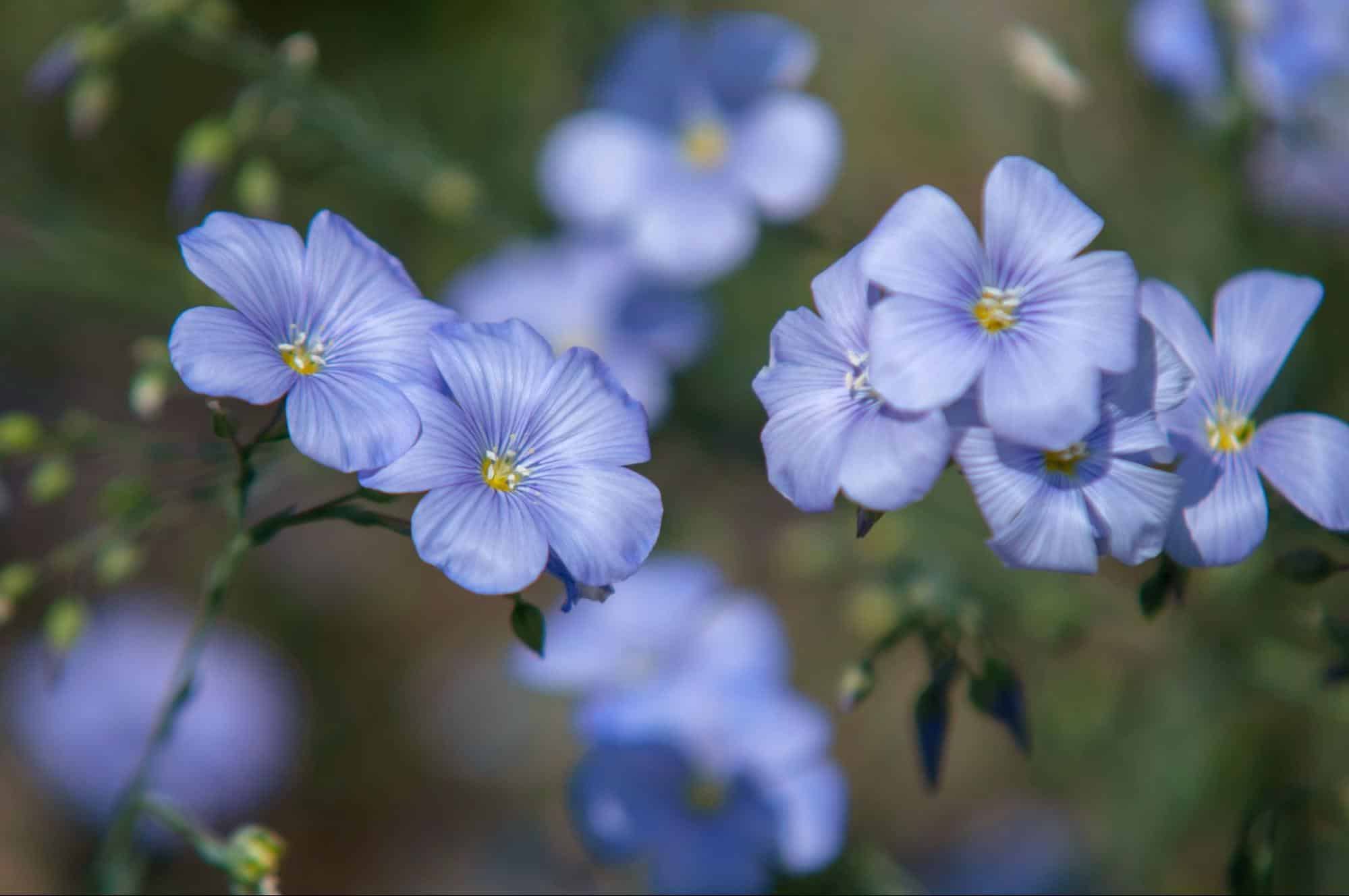
Image source: Pinterest
In the proper condition, flax flowers will grow and bloom abundantly. With a sunny and sheltered position with well-drained loamy or sandy soil, flaxseed flower thrives.
Light Requirement for Flaxseed Flowers
- Flax flowers frowns at excessively hot temperatures. They do better in a sheltered, full-sun position.
Soil Type, Watering, and Fertilization Requirements
- Grows perfectly in light, well-drained, loamy, sandy soil. Dense wet clay soils negatively affect flaxseed flowers.
- Overlying soil nutrient causes flax flower problems, leading to excessive leggy growth.
- Flaxseed flower appreciates evenly moist soil but shouldn’t be too saturated with water.
Fertilization is optional, except if the soil is inferior.
Pests and Diseases
- Susceptible to pests and fungi infection. Powdery mildew, rust, and fusarium wilt are common problems with flaxseed flowers.
- Moth larvae also eat flax flowers and seeds. The larvae are green, small, and similar to inchworms, with white stripes at the upper parts of their body.
- A steady stream of water from the garden hose or insecticidal soap can dislodge the problem.
Propagation
Because of weak root systems, annual flaxes should not be propagated via cuttings or divisions.
The best propagation method is through seed.
Potting and Repotting
- When growing flaxseed flowers in a container or pot, the depth of the pot is more important than the diameter.
- Fill the container with the required soil type with adequate drainage holes at the bottom.
- Keep the soil wet but not overwatered.
Varieties of Flaxseed Flowers
#1 Blue Flaxseed Flower (Linum lewisii)
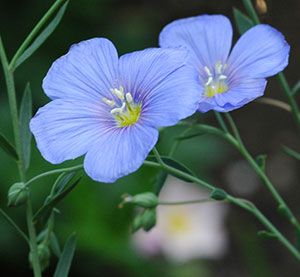
Image Source: Pinterest
Description and Characteristics:
Blue Flaxseed, also known as Lewis flax, is a wildflower species that produces stunning blue flowers with yellow centers. The flowers have five petals and are about one inch wide. The plant can grow up to 30 inches tall with thin, grass-like leaves. Blue flaxseed is a short-lived perennial but can also be grown annually.
Native Range and Habitat:
Blue Flaxseed is native to western North America and can be found in various habitats, including prairies, meadows, and open woodlands. It is well adapted to dry conditions and can tolerate a range of soil types.
Growing Conditions and Care Tips:
- Blue Flaxseed is relatively easy to grow and care for. It prefers full sun to partial shade and well-draining soil. Once established, it is drought-tolerant and does not require much watering.
- Fertilization is unnecessary, but a light application of balanced fertilizer in the spring can help promote blooming.
- Blue flaxseed does not typically have significant pest or disease issues. Deadheading spent blooms can encourage the plant to continue blooming throughout the growing season.
#2 Scarlet Flaxseed Flower (Linum grandiflorum rubrum)
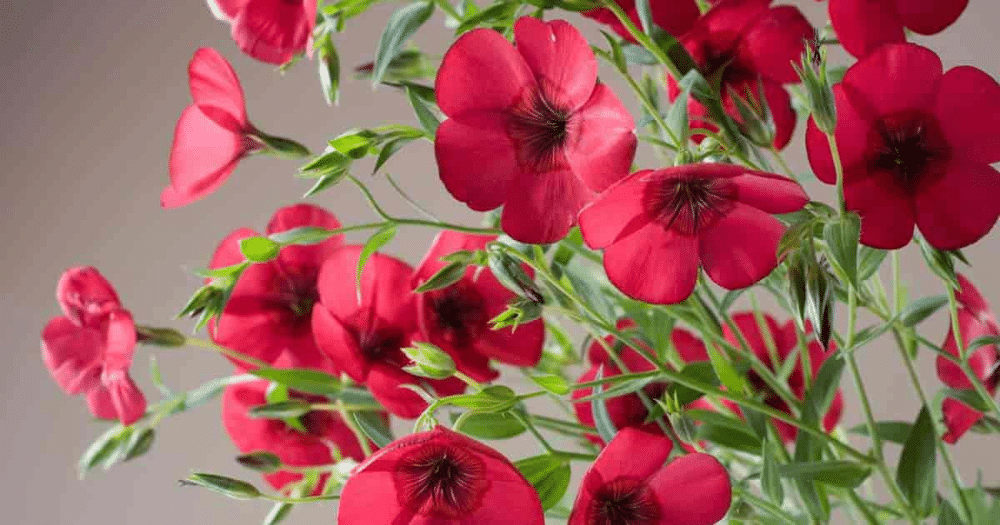
Image Source: Pinterest
Description and Characteristics:
Scarlet flaxseed is a hardy annual plant that produces brilliant, scarlet-red flowers with dark centers. The flowers are cup-shaped and have five petals, each with a black spot at the base. The plant typically grows 12-18 inches and has a bushy growth habit.
Native Range and Habitat:
Scarlet flaxseed is native to the Mediterranean region but is now commonly grown in gardens and wildflower meadows worldwide.
Growing Conditions and Care Tips:
- Scarlet flaxseed prefers well-draining soil and full sun exposure.
- It is relatively drought-tolerant and does not require frequent watering.
- Fertilizer is unnecessary, but adding compost or organic matter to the soil before planting can help improve growth and flowering.
- Scarlet flaxseed is also relatively pest and disease-resistant, making it a low-maintenance plant. The flowers can be deadheaded to encourage continued blooming throughout the growing season.
#3 White Flaxseed Flower (Linum usitatissimum)
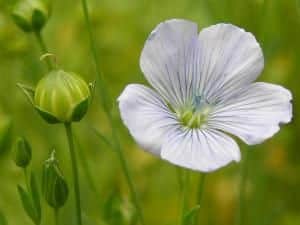
Image Source: Pinterest
Description and Characteristics:
- White flaxseed flowers are small, delicate, and white or pale blue.
- They typically grow in clusters at the top of tall, slender stems.
- The plant can reach a height of 2-3 feet.
Native Range and Habitat:
- White flaxseed is native to the eastern Mediterranean region and western Asia.
- Today, it is widely cultivated in temperate regions throughout the world.
Growing Conditions and Care Tips:
- White flaxseed prefers well-drained soil with a pH between 6.0 and 7.0.
- The plant requires moderate watering but should not be overwatered as it is susceptible to root rot.
- It can be grown from seeds, which should be planted in the early spring.
- White flaxseed requires full sun exposure and moderate temperatures to thrive.
- The plant is relatively low-maintenance and does not require fertilization or pest control in most cases.
#4 Pink Flaxseed Flower (Linum perenne)
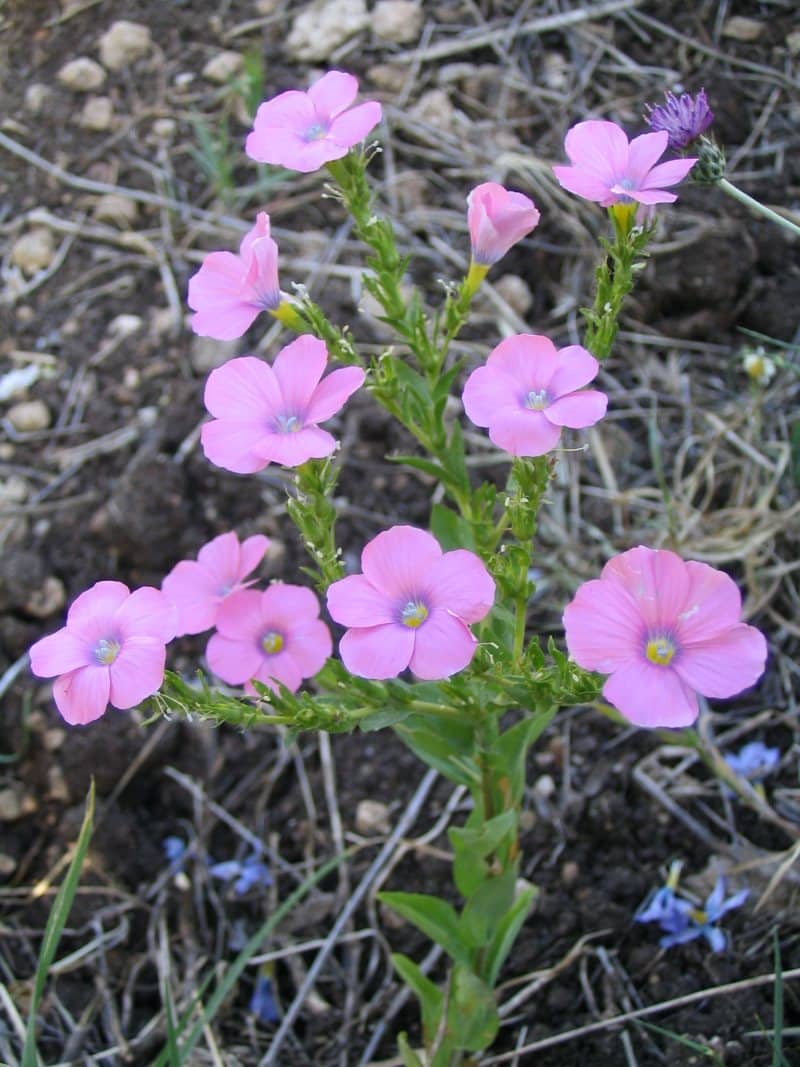
Image Source: Wikipedia
Description and Characteristics:
Pink Flaxseed (Linum perenne), or perennial flax, is a hardy and long-lived flowering plant that produces delicate, pale pink flowers. The flowers are small, measuring only about 1 inch in diameter, but they grow in clusters at the top of tall, slender stems that can reach up to 2 feet.
Native Range and Habitat:
Native to Europe, Asia, and northern Africa, pink flaxseed is commonly found in meadows, fields, and other open areas. It prefers well-draining soil and full sun, but can tolerate some shade. Pink flaxseed is a relatively low-maintenance plant resistant to pests and diseases.
Growing Conditions and Care Tips:
To grow pink flaxseed flowers;
- Start by planting seeds in the spring or fall, and keep the soil moist but not soggy.
- Once established, the plant requires minimal watering and only needs occasional fertilization.
- Prune back the stems after the flowers have finished blooming to encourage new growth and more blooms.
Other Varieties Include;
- Scarlet Flax (Linum grandiflorum rubrum)
- Sapphire Flax (Linum narbonense)
- Appar Flax (Linum appelianum)
- Blue Flax (Linum perenne)
- Evening Flax (Linum strictum)
Choosing the Right Variety
When selecting a flaxseed flower variety, there are several factors to consider to ensure that you choose the suitable combination for your garden conditions and personal preferences. Guy About Home helps gardeners and house owners decide what’s best for their gardens. These factors include:
#1 Climate and Soil Conditions:
Flaxseed flowers grow best in well-draining soils with a pH range of 6.0 to 7.0. Consider the climate in your region and choose a variety suitable for your climate and soil conditions.
#2 Flower Color:
Flaxseed flowers come in various colors, including blue, pink, white, and red. Consider your personal preference and the color scheme of your garden when choosing a variety.
#3 Plant Height:
Flaxseed flowers vary in height, with some varieties reaching up to 3 feet tall. Consider the size of the plants when selecting a type to ensure they fit into your garden design.
#4 Disease Resistance:
Some flaxseed flower varieties are more resistant to diseases than others. Consider the disease resistance of the type you choose to ensure healthy growth and minimal pest problems.
#5 Growing Purpose:
Flaxseed flowers can be grown for their ornamental value or their seeds. Consider your intended purpose for growing flaxseed flowers when selecting a variety.
#6 Seed Production:
If you plan on growing flaxseed flowers for their seeds, select a variety known for producing high yields of quality seeds.
#7 Companion Planting:
Consider companion planting when selecting a flaxseed flower variety. Some varieties may grow well alongside certain plants, while others may not.
Do a Flaxseed Flowers Come Back Every Year?
Flaxseed flowers are annual plants that complete their life cycle in a single growing season and do not come back every year. However, collecting and properly storing their seeds can ensure continuous growth. Choosing a variety suited to your climate, soil, and sunlight conditions is also essential for optimal growth and flowering.
How Often to Fertilize Flaxseed Flower
Flaxseed flowers prefer nutrient-poor soils, so they don’t need frequent fertilization. Over-fertilization can lead to excessive foliage growth and reduced flowering. If you decide to fertilize, use a balanced fertilizer or a slow-release fertilizer at the beginning of the growing season. Avoid fertilizing during blooming, as it can hinder flower production. If the soil is already nutrient-rich, additional fertilization may not be necessary.
Where Do Flaxseed Flowers Grow?
Flaxseed flowers are native to the Mediterranean but are now grown in many parts of the world, including Europe, Asia, and North America. They thrive in cool, temperate climates and can tolerate a range of soil types, from sandy to clay.
You can learn more about the best soil and growing conditions for your flaxseed flowers and other house plants such as Hoya Curtissi, Macodes Petola, etc., when you consult experts at Guy About Home.
Conclusion
Flaxseed flowers are annual plants native to the Mediterranean region but now grow in many parts of the world. They prefer cool, temperate climates and can tolerate various soil types. Flaxseed flowers are often grown for their ornamental value in gardens. This guide addresses all your concerns about flaxseed flowers – growing and best care condition.


